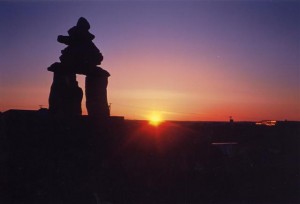http://newswatch.nationalgeographic.com/2010/05/17/indigenous_knowledge_tracks_climate_change/
Being that I’m both a science and humanities teacher, I appreciate both the scientific method and other forms of gathering knowledge and information. As such, I chose my topic for this course’s research paper to look at how indigenous knowledge supports scientific knowledge. My hypothesis was that science would provide the data and quantitative analysis of climate change and that indigenous knowledge would provide the human, spiritual and qualitative analysis of climate change.
This article explains how the scientific community researching climate change actually needs to go to Indigenous peoples first to find out what needs to be researched. One of the researchers gives the example of rainfall averages in her home town of Boulder, Co. In July, her city usually gets an average of 1 inch of rain. If this rain is dispersed through out the month, her lawn is lush and healthy. However, if Boulder gets an inch of rain on July 1, and then none for the rest of the month, her lawn is dead. Weather stations and other tools would not effectively differentiate in this case between 1 inch of rain distributed through the month and 1 inch in one day. In this situation, traditional or Indigenous knowledge would be needed to explain that the data are not actually reflecting the changes that are happening.
Here is yet another example of why we need to look to the human experience of life and the land and rely less on supposed empirical and objective data.
Also notable in this research is the attempt to answer some of the questions that Linda Smith (1999) suggests are necessary when doing research with Indigenous people. This research appears to try to answer the questions “Whose interests does it serve” and “how will its results be disseminated”. There is a serious concern for the traditional ways of the Inuit people, and the research is attempting to help them adjust their weather predicting strategies so they can continue on with traditional ways of life.
